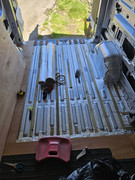richbee wrote: ↑Thu May 29, 2025 10:58 pm
The inverter & dc-dc charger have arrived today


The inverter comes with 2 sets (2 + and 2 - cables) of what I believe are 20mm2 cables to connect to the battery, with terminal crimps labelled as '100A'.
The paperwork is a bit vague, but for me, 1 set of 20mm2 cables is not enough for 2kW at 12V. At 12V it takes 166A (with no losses) - the battery should always be over 12V,so gives a little margin.
25mm2 cables are rated at 170A.
I wonder if it is intended to use both sets of cables in parallel, to reach a reasonable safety margin? Is that sensible?
I was originally planning for 35mm2 (240A) cables to be on the safe side - cables will be less than 1m long to avoid voltage drop issues.
What do you guys reckon?
Don’t focus on what the cables are “rated” at. This doesn’t take into account length, cable max current ratings are not usually “continuous”, and cable manufacturers are often happy with a 70-80℃ surface temp which will burn people and damage nearby materials.
Generally speaking you want a voltage drop of less than 1% on the DC side of a battery inverter. However you also need to consider how you’re using the batteries. Are you charging them from the mains at 2kW or 200W? Are you using a 1.8kW kettle for 5mins or are you drawing large amounts of power for long durations?
You should be aware that you’re operating at power levels for which 12V isn’t really appropriate. I get the reasoning, 2x Voltages (12VDC and 220VAC) is plenty, you get to have the starter and leisure sides connected and separated as appropriate/desirable. The point is that you need to understand the compromises in your system design and mitigate their consequences.
Long story short, 35mm²and <1m each way is borderline, 50mm² is more sensible.
Additionally, beware of cable fraud. It is unfortunately rampant. I pretty much guarantee that any cable you buy from eBay or Amazon will be one size smaller than advertised…




